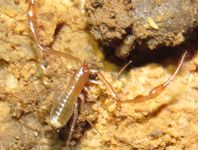Abstract
The genus Cabamofa, previously containing only C. mira from Costa Rica (Jaschhof 2005), is shown here to have a second species in Thailand, which is described and named C. orientalis sp. nov. The new species is known from a single male collected by the TIGER Project (Thailand Inventory Group for Entomological Research), a mass-sampling program to inventory insect diversity in Southeast Asia (Plant et al. 2011; http://sharkeylab.org/tiger, accessed 14 December 2018). As the circumstances of finding indicate, C. orientalis is a decidedly rare species, an attribute applying to perhaps one third of all tropical arthropods (Lim et al. 2012) and most Sciaroidea incertae sedis (Jaschhof 2017), including the Costa Rican C. mira. The latter species was originally described from two females, which were Malaise trapped in 2003 in lowland rain forest (Jaschhof 2005), while a conspecific male, a museum specimen collected in 1922 in an unknown habitat, was detected and described subsequently (Amorim & Rindal 2007). Cabamofa is one of nearly 20 sciaroid genera whose family affiliation has not yet been resolved (Jaschhof 2017), but there is morphological evidence suggesting its close affinity to other Sciaroidea incertae sedis, such as Rogambara Jaschhof, 2005, Ohakunea Tonnoir & Edwards, 1927, and Colonomyia Colless, 1963. These four genera together form the Ohakunea group of Jaschhof (2005), or the Ohakuneinae (as a subfamily of the broadly conceived family Rangomaramidae) of Amorim & Rindal (2007). Recent molecular work (Ševčík et al. 2016, Kaspřák et al. 2019) suggests a more distant phylogenetic position of Ohakunea to other Sciaroidea incertae sedis. The obvious conflict here between morphological and molecular evidence is stimulating fresh interest in the “incertae sedis issue”, as proven by the present contribution. The morphology of C. orientalis provides no new clues as to the systematic position of Cabamofa, or the Ohakunea group, but reveals characters that were previously not known to occur in Cabamofa. The delimitation of this genus is briefly reviewed below. Our finding of C. orientalis extends the geographic distribution of Cabamofa from the New World to the Old World (Oriental) tropics, which consorts with the disjunct (Neotropical-Australasian) areas found in both Colonomyia and Ohakunea. Morphological terminology used here is in accordance with that by Cumming & Wood (2017).
References
Amorim, D.S. & Rindal, E. (2007) Phylogeny of the Mycetophiliformia, with proposal of the subfamilies Heterotrichinae, Ohakuneinae, and Chiletrichinae for the Rangomaramidae (Diptera, Bibionomorpha). Zootaxa, 1535 (1), 1–92.
https://doi.org/10.11646/zootaxa.1535.1.1
Cumming, J.M. & Wood, M.W. (2017) Adult morphology and terminology. In: Kirk-Spriggs, A.H. & Sinclair, B.J. (Eds.), Manual of Afrotropical Diptera. Vol. 1. Introductory chapters and keys to Diptera families. Suricata 4. South African National Biodiversity Institute, Pretoria, pp. 89–133.
Jaschhof, M. (2005) Rogambara and Cabamofa, two new genera of enigmatic sciaroids from Costa Rica (Insecta: Diptera: Sciaroidea). Bonner zoologische Beiträge, 53 (3/4), 323–332.
Jaschhof, M. (2017) 23. Heterotricha-group (Sciaroidea, unassigned to family. In: Kirk-Spriggs, A.H. & Sinclair, B.J. (Eds.), Manual of Afrotropical Diptera. Vol. 2. Nematocerous Diptera and lower Brachycera. Suricata 5. South African National Biodiversity Institute, Pretoria, pp. 601–605.
Kaspřák, D., Kerr, P., Sýkora, V., Tóthová, A. & Ševčík, J. (2019) Molecular phylogeny of the fungus gnat subfamilies Gnoristinae and Mycomyinae, and their position within Mycetophilidae (Diptera). Systematic Entomology, 44, 128–138.
https://doi.org/10.1111/syen.12312
Lim, G.S., Balke, M. & Meier, R. (2012) Determining species boundaries in a world full of rarity: singletons, species delimitation methods. Systematic Biology, 61 (1), 165–169.
https://doi.org/10.1093/sysbio/syr030Plant, A.R., Surin, C., Saokhod, R. & Srisuka, W. (2011) Higher taxon diversity, abundance and community structure of Empididae, Hybotidae and Brachystomatidae (Diptera: Empidoidea) in tropical forests—results of mass-sampling in Thailand. Studia dipterologica, 18, 121–149.
Ševčík, J., Kaspřák, D., Mantič, M., Fitzgerald, S., Ševčíková, T., Tóthová, A. & Jaschhof, M. (2016) Molecular phylogeny of the megadiverse insect infraorder Bibionomorpha sensu lato (Diptera). PeerJ, 4, e2563.
https://doi.org/10.7717/peerj.2563

